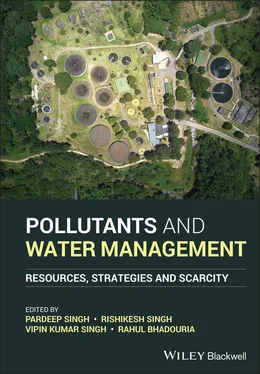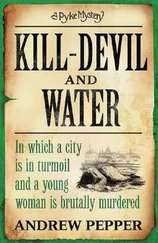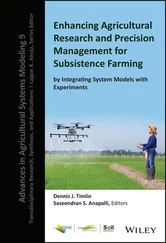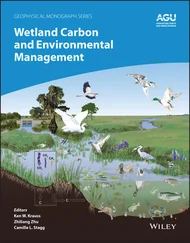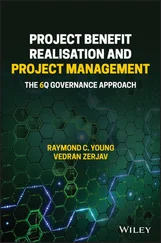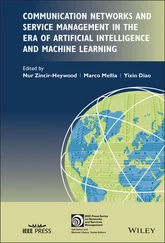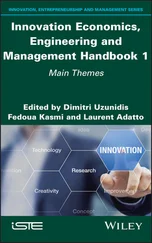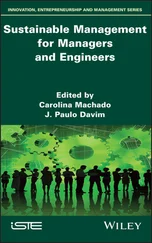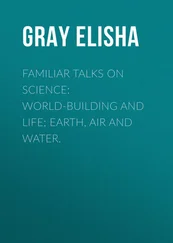Pollutants and Water Management
Здесь есть возможность читать онлайн «Pollutants and Water Management» — ознакомительный отрывок электронной книги совершенно бесплатно, а после прочтения отрывка купить полную версию. В некоторых случаях можно слушать аудио, скачать через торрент в формате fb2 и присутствует краткое содержание. Жанр: unrecognised, на английском языке. Описание произведения, (предисловие) а так же отзывы посетителей доступны на портале библиотеки ЛибКат.
- Название:Pollutants and Water Management
- Автор:
- Жанр:
- Год:неизвестен
- ISBN:нет данных
- Рейтинг книги:3 / 5. Голосов: 1
-
Избранное:Добавить в избранное
- Отзывы:
-
Ваша оценка:
- 60
- 1
- 2
- 3
- 4
- 5
Pollutants and Water Management: краткое содержание, описание и аннотация
Предлагаем к чтению аннотацию, описание, краткое содержание или предисловие (зависит от того, что написал сам автор книги «Pollutants and Water Management»). Если вы не нашли необходимую информацию о книге — напишите в комментариях, мы постараемся отыскать её.
WATER MANAGEMENT Pollutants and Water Management: Resources, Strategies and Scarcity
Pollutants and Water Management
Pollutants and Water Management: Resources, Strategies and Scarcity
Pollutants and Water Management — читать онлайн ознакомительный отрывок
Ниже представлен текст книги, разбитый по страницам. Система сохранения места последней прочитанной страницы, позволяет с удобством читать онлайн бесплатно книгу «Pollutants and Water Management», без необходимости каждый раз заново искать на чём Вы остановились. Поставьте закладку, и сможете в любой момент перейти на страницу, на которой закончили чтение.
Интервал:
Закладка:
Table of Contents
1 Cover
2 Title Page
3 Copyright Page
4 List of Contributors
5 Part I: Water Pollution and Its Security 1 Water Security and Human Health in Relation to Climate Change 1.1 Introduction 1.2 Quantity of Available Water Resources in India 1.3 Quality of Available Water Resources in India 1.4 The Impact of Climate Change on the Quantity of Water Resources 1.5 Impact of Climate Change on the Quality of Water Resources 1.6 The Health Perspective in Association with Water Security and Climate Change 1.7 Major Challenges to Water Security 1.8 Government Initiatives to Ensure Water Security 1.9 Managing Water Resources Under Climate Change 1.10 Conclusion and Recommendations References 2 Assessment of Anthropogenic Pressure and Population Attitude for the Conservation of Kanwar Wetland, Begusarai, India 2.1 Introduction 2.2 Materials and Method 2.3 Results 2.4 Discussion 2.5 Conclusion References 3 Grossly Polluting Industries and Their Effect on Water Resources in India 3.1 Introduction 3.2 Industrialization in India 3.3 Categorization of Industries 3.4 Criteria for Determination of Grossly Polluting Industries 3.5 Different Type of Grossly Polluting Industries and their Impact on Water Bodies 3.6 Major Water Body Pollution Due to Grossly Polluting Industries 3.7 Environmental Infrastructure in Grossly Polluting Industries and its Performance 3.8 Challenges Faced in Industrial Water Regulations 3.9 Conclusion References
6 Part II: Phytoremediation of Water Pollution 4 Phytoremediation 4.1 Introduction 4.2 The Status of Heavy Metal Pollution: Global and Indian Scenarios 4.3 Status of Phytoremediation 4.4 Metal Hyperaccumulators for Phytoremediation 4.5 Advancements in Techniques for the Improvement of the Phytoremediation Ability in Plants and the Status of Genetically Modified Organisms 4.6 Physiological Mechanisms for the Sequestration of Metals 4.7 Socio‐Economic Costs and Benefits of Phytoremediation 4.8 Conclusion and Recommendations References 5 Phytoremediation of Heavy Metals from the Biosphere Perspective and Solutions 5.1 Introduction 5.2 Heavy Metals 5.3 Heavy Metals in Air 5.4 Heavy Metals: Problems and Harmful Effects 5.5 Remediation of Heavy Metals: Need and Conventional Treatments 5.6 Conventional Remedial Techniques: Challenges 5.7 Metal Hyperaccumulators: Scope of Phytoremediation 5.8 Advantages and Limitations of Phytoremediation 5.9 Useful Plants 5.10 Conclusion References 6 Phytoremediation for Heavy Metal RemovalTechnological Advancements 6.1 Introduction 6.2 Phytoremediation 6.3 Bamboo ( Bambusa vulgaris ) 6.4 Mustard ( Brassica juncea ) 6.5 Rhizobacteria 6.6 Seagrass 6.7 Sunflower ( Helianthus annuus ) 6.8 Water Hyacinth ( Eichhornia crassipes Mart) 6.9 Willow ( Salix alba L.) 6.10 Description of Heavy Metal Removal from Water 6.11 Conclusion and Future Research Recommendations References
7 Part III: Microbial Remediation of Water Pollution 7 Advances in Biological Techniques for Remediation of Heavy Metals Leached from a Fly Ash Contaminated Ecosphere 7.1 Introduction 7.2 Status of Fly Ash Heavy Metals: Composition and Remediation 7.3 Treatment of Fly Ash Heavy Metal Contaminated Ecospheres 7.4 Case Study of Gandhinagar Thermal Power Plant, Gandhinagar, India 7.5 Conclusion and Future Prospectives References 8 Microbial Degradation of Organic Contaminants in Water Bodies 8.1 Organic Contaminants in Water 8.2 Treatment of Organic Contaminants Using Microbes 8.3 The Process Design for Microbial Treatment 8.4 Future Prospects 8.5 Conclusion Abbreviations Used References 9 The Fate of Organic Pollutants and Their Microbial Degradation in Water Bodies 9.1 Introduction 9.2 Classification of Organic Pollutants in the Environment 9.3 Organic Contaminants in Water and Their Sources 9.4 Effects of Organic Pollutants on Aquatic Ecosystems 9.5 The Fate of Organic Pollutants in Natural Water Bodies 9.6 Microbial Enzymes in the Degradation of Organic Pollutants 9.7 Approaches for Organic Pollutant Bioremediation 9.8 Microbial Bioaccumulation of Organic Pollutant in Water Bodies 9.9 Factors Affecting Microbial Degradation 9.10 Conclusion and Future Recommendations References
8 Part IV: Removal of Water Pollutants by Nanotechnology 10 Detection and Removal of Heavy Metals from Wastewater Using Nanomaterials 10.1 Introduction 10.2 Sources of Heavy Metals in Wastewater 10.3 Toxicity of Heavy Metals Concerning Human Health and Environment 10.4 Role of Nanomaterials in the Removal of Heavy Metals 10.5 Different Types of Nanoadsorbents 10.6 Comparison of Adsorption Capacities of Various Heavy Metal Ions by Nanomaterials and Conventional Methods 10.7 Conclusion and Future Trends Acknowledgments Conflict of Interest References 11 Spinel Ferrite Magnetic Nanoparticles 11.1 Introduction 11.2 Spinel Ferrite Nanoparticles 11.3 Synthesis of Spinel Ferrite Magnetic Nanoparticles 11.4 Adsorption and Photocatalytic Degradation Mechanisms 11.5 Recovery and Reuse 11.6 Future Perspectives 11.7 Conclusion References 12 Biocompatible Cellulose‐Based Sorbents for Potential Application in Heavy Metal Ion Removal from Wastewater 12.1 Introduction 12.2 Heavy Metal Ions as Pollutants 12.3 Cellulose as Biosorbents: Fundamentals to the Mechanistic Approach 12.4 Modification of Cellulose 12.5 Removal of Various HMi 12.6 Adsorption and Kinetic Studies 12.7 The Role of Thermodynamics 12.8 Prospects Toward Sustainability 12.9 Summary References
9 Part V: Advances in Remediation of Water Pollution 13 Advances in Membrane Technology Used in the Wastewater Treatment Process 13.1 Introduction 13.2 Membrane Technologies for Wastewater Treatment 13.3 Advancements in Membrane Technology for Wastewater Treatment 13.4 Conclusions References 14 Occurrence, Fate, and Remediation of Arsenic 14.1 Introduction 14.2 Sources of Arsenic Contamination in the Environment 14.3 Health Effects of Arsenic Toxicity 14.4 Remediation Techniques for Arsenic Contamination 14.5 Coagulation and Flocculation 14.6 Bioremediation for the Treatment of Arsenic 14.7 The Fate of Arsenic in the Environment 14.8 Conclusion References 15 Physical and Chemical Methods for Heavy Metal Removal 15.1 Introduction 15.2 Toxicity of Heavy Metals 15.3 Methods 15.4 Chemical Methods for Heavy Metal Removal 15.5 Conclusion References
10 Part VI: Policy Dimensions on Water Security 16 The Role of Government and the Public in Water Resource Management in India 16.1 Introduction 16.2 Distribution of Water in India 16.3 Challenges in Water Resource Management 16.4 Traditional Ways of Water Resource Management in India 16.5 Present Management Measures 16.6 The Role of the Public in Water Resource Management 16.7 Recommendations and Conclusion References Web References/Online Sources
11 Index
12 End User License Agreement
List of Tables
1 Chapter 1 Table 1.1 Annual surface water availability of India. Table 1.2 Overview of surface water potential of Indian rivers. Table 1.3 Groundwater resources assessment from 2004–2017. Table 1.4 Number of states and districts affected by geogenic contamination i... Table 1.5 International reports on current and future demands of water of Ind...
2 Chapter 2 Table 2.1 Category wise distribution of wetlands in India. Table 2.2 Land use land cover change analysis in the Kanwar wetland between 1... Table 2.3 Water quality parameters of the Kanwar wetland. Table 2.4 Sediment quality parameters of the Kanwar wetland. Table 2.5 Heavy metal content in various species of the Kanwar wetland. Table 2.6 Changes in village‐wise population and number of households. Table 2.7 Socio‐economic characteristics of three resource user groups based ... Table 2.8 Dependence of resource user groups (in %) on wetland resources and ... Table 2.9 Attitude of people for conservation.
3 Chapter 3 Table 3.1 Four major states comprising large numbers of grossly polluting ind... Table 3.2 Impact of different types of industries on water bodies. Table 3.3 Lists of operational effluent treatment plants, with an online cont...
Читать дальшеИнтервал:
Закладка:
Похожие книги на «Pollutants and Water Management»
Представляем Вашему вниманию похожие книги на «Pollutants and Water Management» списком для выбора. Мы отобрали схожую по названию и смыслу литературу в надежде предоставить читателям больше вариантов отыскать новые, интересные, ещё непрочитанные произведения.
Обсуждение, отзывы о книге «Pollutants and Water Management» и просто собственные мнения читателей. Оставьте ваши комментарии, напишите, что Вы думаете о произведении, его смысле или главных героях. Укажите что конкретно понравилось, а что нет, и почему Вы так считаете.
